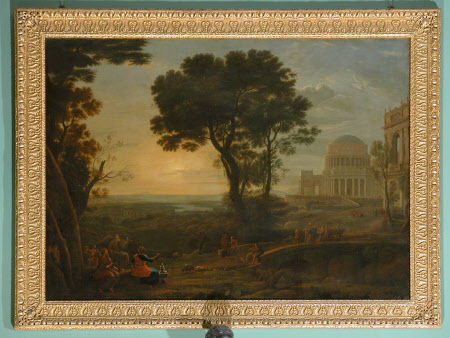Procession to the Temple of Apollo at Delos (after Claude Lorrain)
John Plimmer (Dorchester 1722 - Rome 1760)
Category
Art / Oil paintings
Date
1759 - 1760
Materials
Oil on canvas
Measurements
1498 x 2006 mm (59 x 79 in)
Place of origin
Rome
Order this imageCollection
Stourhead, Wiltshire
NT 732178
Caption
Plimmer became the pupil of the great landscape painter, Richard Wilson in Rome in 1755 and is recorded as living with the art dealer, Thomas Jenkins, after Wilson had left in August 1757, on the Via del Corso between 1758 and his premature death in 1760. Jenkins wrote to Henry Hoare, who had financed Plimmer’s trip: "I can safely say that he [Plimmer] is without comparison the best landskip painter we have at this time in Italy and is allowed to be such by all the Dilettanti here, he has and does study Claude with success as I believe you will think when you see his works."( 2 June 1759). The following year Plimmer dispatched this painting which appears to be the only firmly attributed work to the artist in a public collection. It undoubtedly proved to be an inspiration for the creation of his patron’s magnificent gardens at Stourhead.
Summary
Oil painting on unlined canvas, Procession to the Temple of Apollo at Delos (after Claude Lorrain) by John Plimmer (Dorchester 1722 - Rome 1760), 1759-1760. Inscribed as if incised in stone on the bridge: HAC.ITUR.IN.DELPHES. This picture is copy of a painting by Claude Lorrain in the Doria Pamphilj, Rome and is a pendant to another painting in Stourhead, attributed to Andrea Locatelli, also a copy after another Claude Lorrain, that is its companion in the Doria Pamphilj, Rome. Plimmer went to Rome in 1755 and became Richard Wilson's pupil, spent time in Naples in 1757 and is recorded as living with the painter and art dealer Thomas Jenkins (1722- 1798) in Rome on the Via del Corso between 1758 and his premature death in November 1760. On 2 June 1759, Thomas Jenkins wrote to Henry Hoare: "I can safely say that he [John Plimmer; Richard Wilson had left Rome in August 1757] is without comparison the best landskip painter we have at this time in Italy and is allowed to be such by all the Dilettanti here, he has and does study Claude with success as I believe you will think when you see his works." And Plimmer himself wrote to his patron in June 1759: "I have endeavoured to imitate Claude and Nature with as much care as I possibly could ever since Mr Wilson left Rome and I have been my own master." In July 1760 he dispatched this painting but only months later was dead.
Provenance
Commissoned in 1759 by Henry Hoare II (1705 - 85), despached in July 1760 and in the house by 1761; gven to the National Trust along with the house, its grounds, and the rest of contents by Sir Henry Hugh Arthur Hoare, 6th Bt (1865 – 1947) in 1946.
Credit line
Stourhead, The Hoare Collection (National Trust)
Marks and inscriptions
Recto: Inscribed as if incised in stone on the bridge: HAC.ITUR.IN.DELPHES
Makers and roles
John Plimmer (Dorchester 1722 - Rome 1760), artist after Claude Lorrain (Champagne 1600 – Rome 1682) previously catalogued as attributed to Andrea Locatelli (Rome 1695 – Rome 1741?) previously catalogued as attributed to Hendrik Frans van Lint
References
Richard Wilson and the Transformation of European Painting (eds. Martin Postle and Robin Simon), Yale Center for British Art, New Haven, 6 March - 1 June 2014 and Amgueddfa Cymru - National Museum Wales, Cardiff 5 July - 26 October 2014, fig. 73

